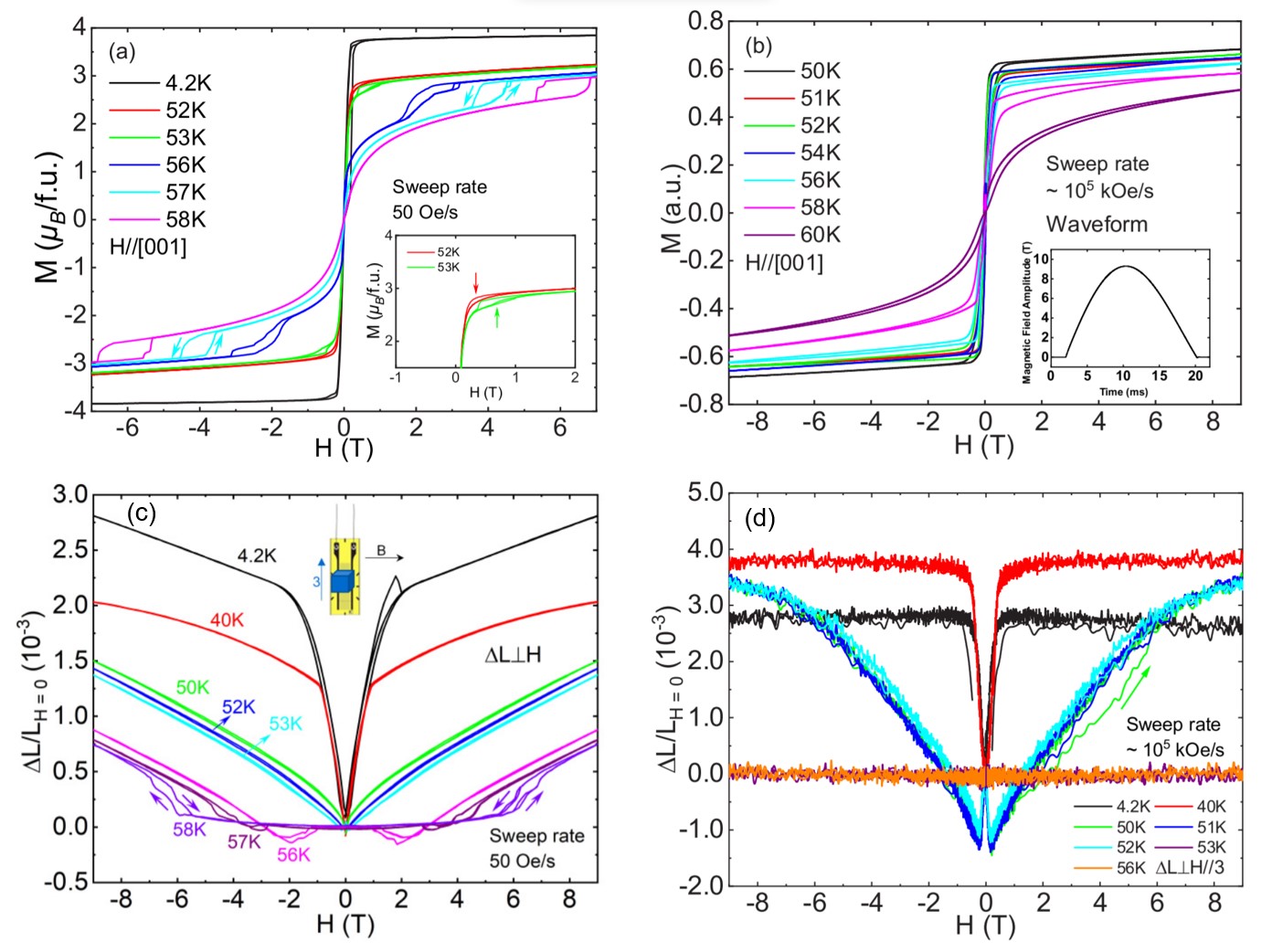
(a), (b) Magnetization under static magnetic field and pulsed magnetic field, respectively. (c), (d) Magnetostriction under static magnetic field and pulsed magnetic field, respectively.
Background
In transition metal compounds, the orbital degrees of freedom ofdelectron play an important role in electric and magnetic properties.At present, some intriguing phenomena caused by the interaction of spin, orbital, and lattice degrees of freedom have attracted considerable attention in the field of condensed matter physics. Spinel vanadium oxides with general formula AV2O4, where A can be either a magnetic or a nonmagnetic species such as Mg, Zn, Cd, Fe, Co, or Mn, and where the interplay of spin, orbital degrees of freedom of the A and V ions is important, have attracted extensive interest due to a lot of intriguing physical phenomena, such as metal-insulator transition, Orbital Ordering (OO), geometrical frustration, and multiferroicity.Previous studies have shown that, with the decrease of temperature, MnV2O4 undergoes a paramagnetic (PM) to collinear (CL) ferrimagnetic transition at TN ≈ 56 K with the Mn and V spin moments antiparallel. At T*≈ 52 K, a CL to non-CL (NCL) ferrimagnetic transition occurs, accompanied by a cubic-to-tetragonal structural transition induced by the so-called A-type antiferro OO. Recently, it has been widely accepted that the PM to NCL ferrimagnetic transition and the cubic-to-tetragonal structural transition both occur at TN≈ 56 K, while the origin of the second transition at T*≈ 52 K is still under debate.
What we discover?
In this study, we have systematically investigated the dynamic properties of magnetization, magnetostriction of spinel MnV2O4 single crystal using a pulsed magnet (with the field sweep rate∼105 kOe/s). The magnetization results measured in pulsed magnetic field are different from that measured in static magnetic field, abnormal magnetization and magnetostriction behaviors were observed under the pulsedmagnetic field, we suggest that an quasi-adiabatic process was established due to the rather weak spin-orbital correlation effect in MnV2O4 and the fast field sweep rate of the pulsed magnetic field. Our results also suggest that the NCL and CL phases coexist between TN and T*, and that the transition at T* is closely related to the orbital state of MnV2O4. The experimental results show that this compound provides an ideal playground for the study of the weak spin-orbital interaction in the t2g orbitals, and the pulsed high magnetic field is a powerful tool for the study of the dynamic magnetic properties.
Why is this important?
The analysis of the magnetization, dielectric permittivity and magnetostriction in static magnetic field shows that the CL and NCL spin configurations coexist between TN and T∗, and the NCL spin configuration can be induced by applied magnetic field. Based on the orbital state of MnV2O4 and the Kugel-Khomskii model, we propose an quasi-adiabatic spin-orbital correlation mechanism in which the interaction between the spin and the t2g orbital of V3+ ions is rather weak; this weak interaction results in the magnetic properties of MnV2O4 is related to the field sweep rate. The different responses depending on the sweep rate of the magnetic field is a unique finding to clarify the role of OO of t2g.
Why did we need WHMFC?
Pulsed magnetic field is an ideal tool to study the dynamic properties of magnetic systems because of its ultrafast field sweep rate. Usually high-field sweep rates may delay magnetic phase transition, causing the critical field moves to higher magnetic-field regime; this is the so-called magnetic viscosity. However, the situation in MnV2O4 is counterintuitive. Therefore, the pulsed magnetic field unveils the unusual dynamic propertied of MnV2O4.
Who did the research?
Hao-Yu Niu, Zhuo Zeng, Yu-Jie Song, Hao Huang, You-Yuan Liang, De-Quan Jiang, Zhao-Ming Tian, Zhong-Wen Ouyang, and Zheng-Cai Xia
Wuhan National High Magnetic Field Center and School of Physics of Huazhong University of Science and Technology, Wuhan 430074, China
Acknowledgments
This work is supported in part by the National Natural Science Foundation of China (Grants No. 11674115, No. 51861135104, and No. 21875249).
Link
https://doi.org/10.1103/PhysRevB.105.054401
